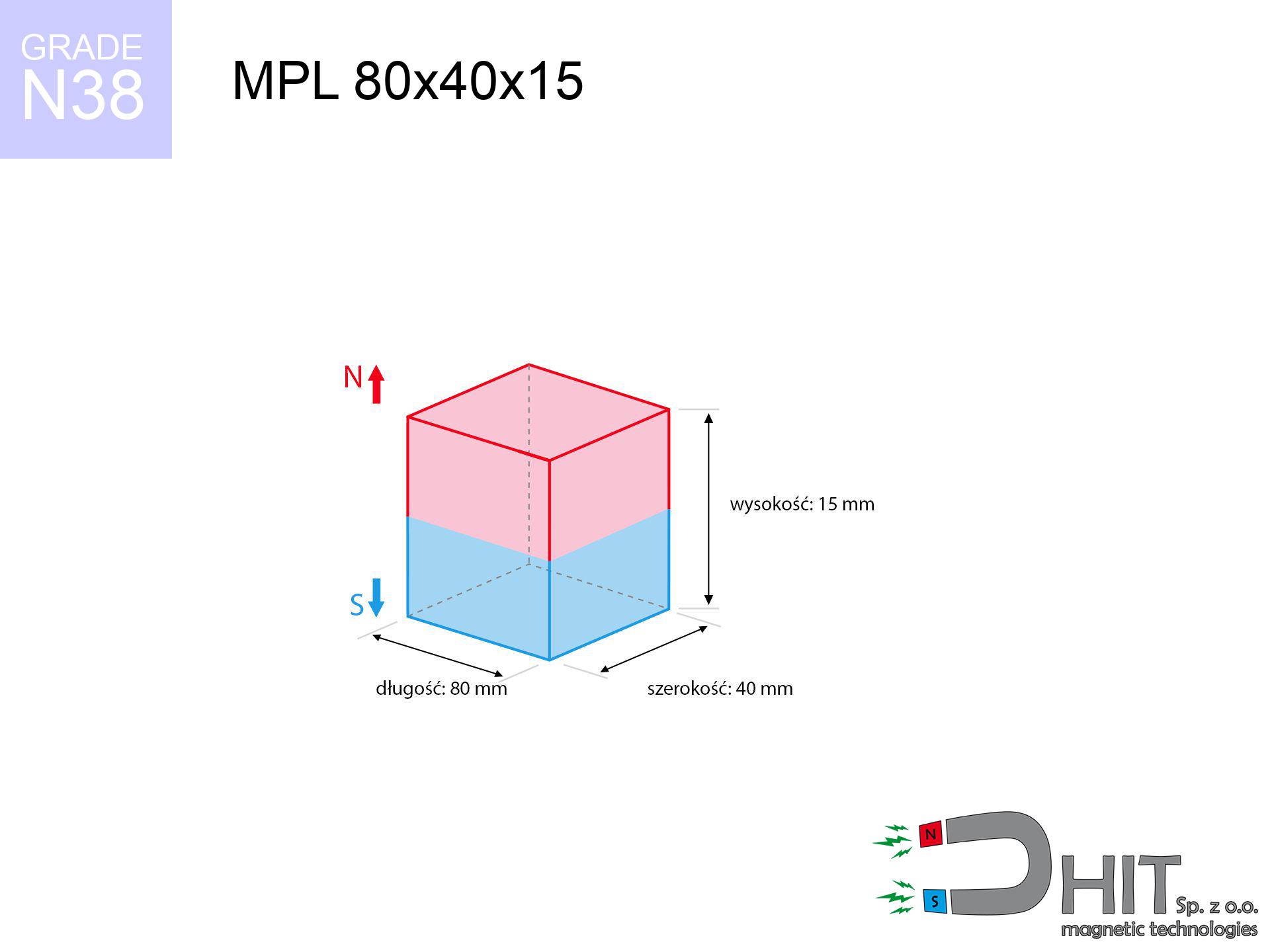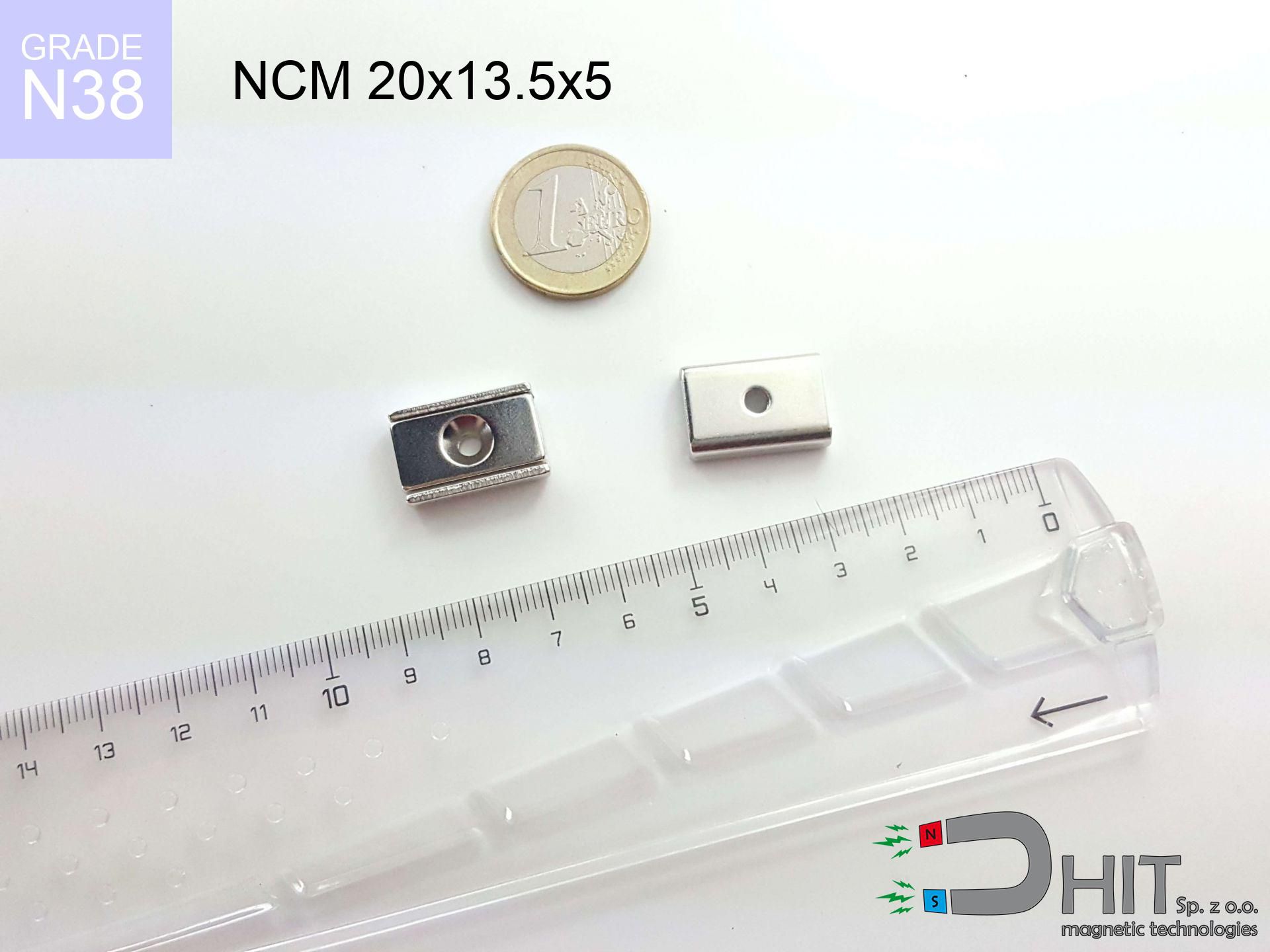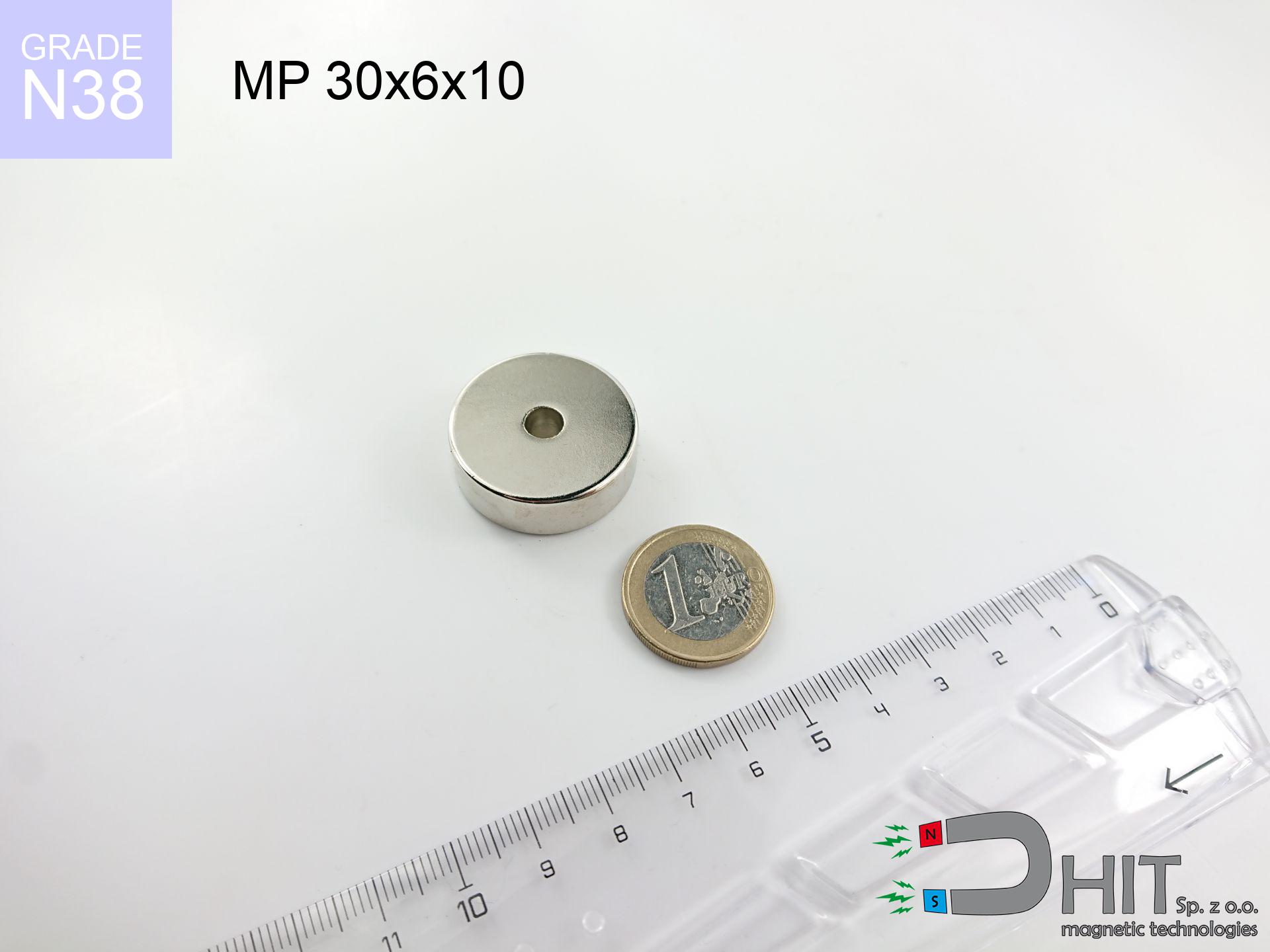MPL 80x40x15 / N38 - lamellar magnet
lamellar magnet
Catalog no 020177
GTIN/EAN: 5906301811831
length
80 mm [±0,1 mm]
Width
40 mm [±0,1 mm]
Height
15 mm [±0,1 mm]
Weight
360 g
Magnetization Direction
↑ axial
Load capacity
73.57 kg / 721.75 N
Magnetic Induction
285.78 mT / 2858 Gs
Coating
[NiCuNi] Nickel
139.54 ZŁ with VAT / pcs + price for transport
113.45 ZŁ net + 23% VAT / pcs
bulk discounts:
Need more?Do you have a hard time selecting?
Call us
+48 22 499 98 98
otherwise get in touch by means of
contact form
our website.
Lifting power as well as structure of a magnet can be checked using our
online calculation tool.
Orders submitted before 14:00 will be dispatched today!
MPL 80x40x15 / N38 - lamellar magnet
Specification / characteristics MPL 80x40x15 / N38 - lamellar magnet
| properties | values |
|---|---|
| Cat. no. | 020177 |
| GTIN/EAN | 5906301811831 |
| Production/Distribution | Dhit sp. z o.o. |
| Country of origin | Poland / China / Germany |
| Customs code | 85059029 |
| length | 80 mm [±0,1 mm] |
| Width | 40 mm [±0,1 mm] |
| Height | 15 mm [±0,1 mm] |
| Weight | 360 g |
| Magnetization Direction | ↑ axial |
| Load capacity ~ ? | 73.57 kg / 721.75 N |
| Magnetic Induction ~ ? | 285.78 mT / 2858 Gs |
| Coating | [NiCuNi] Nickel |
| Manufacturing Tolerance | ±0.1 mm |
Magnetic properties of material N38
| properties | values | units |
|---|---|---|
| remenance Br [min. - max.] ? | 12.2-12.6 | kGs |
| remenance Br [min. - max.] ? | 1220-1260 | mT |
| coercivity bHc ? | 10.8-11.5 | kOe |
| coercivity bHc ? | 860-915 | kA/m |
| actual internal force iHc | ≥ 12 | kOe |
| actual internal force iHc | ≥ 955 | kA/m |
| energy density [min. - max.] ? | 36-38 | BH max MGOe |
| energy density [min. - max.] ? | 287-303 | BH max KJ/m |
| max. temperature ? | ≤ 80 | °C |
Physical properties of sintered neodymium magnets Nd2Fe14B at 20°C
| properties | values | units |
|---|---|---|
| Vickers hardness | ≥550 | Hv |
| Density | ≥7.4 | g/cm3 |
| Curie Temperature TC | 312 - 380 | °C |
| Curie Temperature TF | 593 - 716 | °F |
| Specific resistance | 150 | μΩ⋅cm |
| Bending strength | 250 | MPa |
| Compressive strength | 1000~1100 | MPa |
| Thermal expansion parallel (∥) to orientation (M) | (3-4) x 10-6 | °C-1 |
| Thermal expansion perpendicular (⊥) to orientation (M) | -(1-3) x 10-6 | °C-1 |
| Young's modulus | 1.7 x 104 | kg/mm² |
Technical modeling of the magnet - technical parameters
These values constitute the result of a engineering analysis. Values rely on algorithms for the material Nd2Fe14B. Operational performance might slightly differ from theoretical values. Use these data as a reference point during assembly planning.
MPL 80x40x15 / N38
| Distance (mm) | Induction (Gauss) / mT | Pull Force (kg) | Risk Status |
|---|---|---|---|
| 0 mm |
2857 Gs
285.7 mT
|
73.57 kg / 73570.0 g
721.7 N
|
dangerous! |
| 1 mm |
2778 Gs
277.8 mT
|
69.55 kg / 69546.1 g
682.2 N
|
dangerous! |
| 2 mm |
2693 Gs
269.3 mT
|
65.33 kg / 65331.2 g
640.9 N
|
dangerous! |
| 3 mm |
2603 Gs
260.3 mT
|
61.05 kg / 61047.5 g
598.9 N
|
dangerous! |
| 5 mm |
2415 Gs
241.5 mT
|
52.56 kg / 52559.7 g
515.6 N
|
dangerous! |
| 10 mm |
1943 Gs
194.3 mT
|
34.02 kg / 34021.1 g
333.7 N
|
dangerous! |
| 15 mm |
1527 Gs
152.7 mT
|
21.01 kg / 21007.7 g
206.1 N
|
dangerous! |
| 20 mm |
1192 Gs
119.2 mT
|
12.81 kg / 12808.1 g
125.6 N
|
dangerous! |
| 30 mm |
736 Gs
73.6 mT
|
4.89 kg / 4886.6 g
47.9 N
|
strong |
| 50 mm |
313 Gs
31.3 mT
|
0.88 kg / 884.8 g
8.7 N
|
weak grip |
MPL 80x40x15 / N38
| Distance (mm) | Friction coefficient | Pull Force (kg) |
|---|---|---|
| 0 mm | Stal (~0.2) |
14.71 kg / 14714.0 g
144.3 N
|
| 1 mm | Stal (~0.2) |
13.91 kg / 13910.0 g
136.5 N
|
| 2 mm | Stal (~0.2) |
13.07 kg / 13066.0 g
128.2 N
|
| 3 mm | Stal (~0.2) |
12.21 kg / 12210.0 g
119.8 N
|
| 5 mm | Stal (~0.2) |
10.51 kg / 10512.0 g
103.1 N
|
| 10 mm | Stal (~0.2) |
6.80 kg / 6804.0 g
66.7 N
|
| 15 mm | Stal (~0.2) |
4.20 kg / 4202.0 g
41.2 N
|
| 20 mm | Stal (~0.2) |
2.56 kg / 2562.0 g
25.1 N
|
| 30 mm | Stal (~0.2) |
0.98 kg / 978.0 g
9.6 N
|
| 50 mm | Stal (~0.2) |
0.18 kg / 176.0 g
1.7 N
|
MPL 80x40x15 / N38
| Surface type | Friction coefficient / % Mocy | Max load (kg) |
|---|---|---|
| Raw steel |
µ = 0.3
30% Nominalnej Siły
|
22.07 kg / 22071.0 g
216.5 N
|
| Painted steel (standard) |
µ = 0.2
20% Nominalnej Siły
|
14.71 kg / 14714.0 g
144.3 N
|
| Oily/slippery steel |
µ = 0.1
10% Nominalnej Siły
|
7.36 kg / 7357.0 g
72.2 N
|
| Magnet with anti-slip rubber |
µ = 0.5
50% Nominalnej Siły
|
36.79 kg / 36785.0 g
360.9 N
|
MPL 80x40x15 / N38
| Steel thickness (mm) | % power | Real pull force (kg) |
|---|---|---|
| 0.5 mm |
|
2.45 kg / 2452.3 g
24.1 N
|
| 1 mm |
|
6.13 kg / 6130.8 g
60.1 N
|
| 2 mm |
|
12.26 kg / 12261.7 g
120.3 N
|
| 5 mm |
|
30.65 kg / 30654.2 g
300.7 N
|
| 10 mm |
|
61.31 kg / 61308.3 g
601.4 N
|
MPL 80x40x15 / N38
| Ambient temp. (°C) | Power loss | Remaining pull | Status |
|---|---|---|---|
| 20 °C | 0.0% |
73.57 kg / 73570.0 g
721.7 N
|
OK |
| 40 °C | -2.2% |
71.95 kg / 71951.5 g
705.8 N
|
OK |
| 60 °C | -4.4% |
70.33 kg / 70332.9 g
690.0 N
|
|
| 80 °C | -6.6% |
68.71 kg / 68714.4 g
674.1 N
|
|
| 100 °C | -28.8% |
52.38 kg / 52381.8 g
513.9 N
|
MPL 80x40x15 / N38
| Gap (mm) | Attraction (kg) (N-S) | Repulsion (kg) (N-N) |
|---|---|---|
| 0 mm |
161.08 kg / 161083 g
1580.2 N
4 384 Gs
|
N/A |
| 1 mm |
156.77 kg / 156775 g
1538.0 N
5 638 Gs
|
141.10 kg / 141097 g
1384.2 N
~0 Gs
|
| 2 mm |
152.27 kg / 152273 g
1493.8 N
5 556 Gs
|
137.05 kg / 137046 g
1344.4 N
~0 Gs
|
| 3 mm |
147.69 kg / 147688 g
1448.8 N
5 472 Gs
|
132.92 kg / 132920 g
1303.9 N
~0 Gs
|
| 5 mm |
138.36 kg / 138363 g
1357.3 N
5 297 Gs
|
124.53 kg / 124527 g
1221.6 N
~0 Gs
|
| 10 mm |
115.08 kg / 115081 g
1128.9 N
4 830 Gs
|
103.57 kg / 103573 g
1016.0 N
~0 Gs
|
| 20 mm |
74.49 kg / 74490 g
730.7 N
3 886 Gs
|
67.04 kg / 67041 g
657.7 N
~0 Gs
|
| 50 mm |
17.20 kg / 17197 g
168.7 N
1 867 Gs
|
15.48 kg / 15477 g
151.8 N
~0 Gs
|
MPL 80x40x15 / N38
| Object / Device | Limit (Gauss) / mT | Safe distance |
|---|---|---|
| Pacemaker | 5 Gs (0.5 mT) | 26.0 cm |
| Hearing aid | 10 Gs (1.0 mT) | 20.5 cm |
| Timepiece | 20 Gs (2.0 mT) | 16.0 cm |
| Mobile device | 40 Gs (4.0 mT) | 12.5 cm |
| Car key | 50 Gs (5.0 mT) | 11.5 cm |
| Payment card | 400 Gs (40.0 mT) | 4.5 cm |
| HDD hard drive | 600 Gs (60.0 mT) | 3.5 cm |
MPL 80x40x15 / N38
| Start from (mm) | Speed (km/h) | Energy (J) | Predicted outcome |
|---|---|---|---|
| 10 mm |
18.11 km/h
(5.03 m/s)
|
4.56 J | |
| 30 mm |
25.99 km/h
(7.22 m/s)
|
9.38 J | |
| 50 mm |
32.48 km/h
(9.02 m/s)
|
14.65 J | |
| 100 mm |
45.61 km/h
(12.67 m/s)
|
28.89 J |
MPL 80x40x15 / N38
| Technical parameter | Value / Description |
|---|---|
| Coating type | [NiCuNi] Nickel |
| Layer structure | Nickel - Copper - Nickel |
| Layer thickness | 10-20 µm |
| Salt spray test (SST) ? | 24 h |
| Recommended environment | Indoors only (dry) |
MPL 80x40x15 / N38
| Parameter | Value | SI Unit / Description |
|---|---|---|
| Magnetic Flux | 94 833 Mx | 948.3 µWb |
| Pc Coefficient | 0.33 | Low (Flat) |
MPL 80x40x15 / N38
| Environment | Effective steel pull | Effect |
|---|---|---|
| Air (land) | 73.57 kg | Standard |
| Water (riverbed) |
84.24 kg
(+10.67 kg Buoyancy gain)
|
+14.5% |
1. Wall mount (shear)
*Caution: On a vertical surface, the magnet retains merely approx. 20-30% of its max power.
2. Efficiency vs thickness
*Thin steel (e.g. computer case) drastically weakens the holding force.
3. Heat tolerance
*For N38 grade, the critical limit is 80°C.
4. Demagnetization curve and operating point (B-H)
chart generated for the permeance coefficient Pc (Permeance Coefficient) = 0.33
This simulation demonstrates the magnetic stability of the selected magnet under specific geometric conditions. The solid red line represents the demagnetization curve (material potential), while the dashed blue line is the load line based on the magnet's geometry. The Pc (Permeance Coefficient), also known as the load line slope, is a dimensionless value that describes the relationship between the magnet's shape and its magnetic stability. The intersection of these two lines (the black dot) is the operating point — it determines the actual magnetic flux density generated by the magnet in this specific configuration. A higher Pc value means the magnet is more 'slender' (tall relative to its area), resulting in a higher operating point and better resistance to irreversible demagnetization caused by external fields or temperature. A value of 0.42 is relatively low (typical for flat magnets), meaning the operating point is closer to the 'knee' of the curve — caution is advised when operating at temperatures near the maximum limit to avoid strength loss.
Material specification
| iron (Fe) | 64% – 68% |
| neodymium (Nd) | 29% – 32% |
| boron (B) | 1.1% – 1.2% |
| dysprosium (Dy) | 0.5% – 2.0% |
| coating (Ni-Cu-Ni) | < 0.05% |
Ecology and recycling (GPSR)
| recyclability (EoL) | 100% |
| recycled raw materials | ~10% (pre-cons) |
| carbon footprint | low / zredukowany |
| waste code (EWC) | 16 02 16 |
See also offers
Pros and cons of Nd2Fe14B magnets.
Strengths
- They virtually do not lose power, because even after 10 years the performance loss is only ~1% (according to literature),
- They are noted for resistance to demagnetization induced by external disturbances,
- The use of an aesthetic layer of noble metals (nickel, gold, silver) causes the element to have aesthetics,
- They are known for high magnetic induction at the operating surface, which affects their effectiveness,
- Through (adequate) combination of ingredients, they can achieve high thermal strength, enabling functioning at temperatures approaching 230°C and above...
- Possibility of detailed modeling and optimizing to atypical requirements,
- Fundamental importance in modern technologies – they find application in hard drives, electromotive mechanisms, advanced medical instruments, also multitasking production systems.
- Compactness – despite small sizes they generate large force, making them ideal for precision applications
Disadvantages
- At very strong impacts they can crack, therefore we recommend placing them in special holders. A metal housing provides additional protection against damage and increases the magnet's durability.
- NdFeB magnets demagnetize when exposed to high temperatures. After reaching 80°C, many of them experience permanent drop of power (a factor is the shape and dimensions of the magnet). We offer magnets specially adapted to work at temperatures up to 230°C marked [AH], which are very resistant to heat
- They rust in a humid environment. For use outdoors we suggest using waterproof magnets e.g. in rubber, plastic
- We recommend casing - magnetic mount, due to difficulties in creating threads inside the magnet and complex forms.
- Potential hazard related to microscopic parts of magnets are risky, in case of ingestion, which becomes key in the context of child health protection. Furthermore, tiny parts of these devices can disrupt the diagnostic process medical in case of swallowing.
- With budget limitations the cost of neodymium magnets can be a barrier,
Lifting parameters
Maximum holding power of the magnet – what contributes to it?
- with the application of a yoke made of special test steel, ensuring full magnetic saturation
- possessing a thickness of at least 10 mm to avoid saturation
- characterized by smoothness
- with zero gap (no coatings)
- under perpendicular force vector (90-degree angle)
- at temperature approx. 20 degrees Celsius
Key elements affecting lifting force
- Clearance – existence of any layer (paint, dirt, gap) interrupts the magnetic circuit, which lowers capacity steeply (even by 50% at 0.5 mm).
- Angle of force application – highest force is reached only during perpendicular pulling. The shear force of the magnet along the plate is standardly many times smaller (approx. 1/5 of the lifting capacity).
- Substrate thickness – for full efficiency, the steel must be sufficiently thick. Thin sheet limits the attraction force (the magnet "punches through" it).
- Steel grade – the best choice is high-permeability steel. Cast iron may attract less.
- Surface condition – smooth surfaces ensure maximum contact, which increases force. Uneven metal weaken the grip.
- Thermal environment – temperature increase results in weakening of force. Check the thermal limit for a given model.
Lifting capacity was determined using a steel plate with a smooth surface of optimal thickness (min. 20 mm), under perpendicular detachment force, whereas under shearing force the load capacity is reduced by as much as 75%. Moreover, even a slight gap between the magnet’s surface and the plate reduces the holding force.
Allergy Warning
It is widely known that nickel (the usual finish) is a strong allergen. For allergy sufferers, prevent touching magnets with bare hands and opt for encased magnets.
This is not a toy
Always store magnets out of reach of children. Risk of swallowing is significant, and the effects of magnets clamping inside the body are tragic.
Maximum temperature
Watch the temperature. Exposing the magnet above 80 degrees Celsius will permanently weaken its properties and pulling force.
Electronic devices
Data protection: Neodymium magnets can damage payment cards and delicate electronics (heart implants, hearing aids, mechanical watches).
Pacemakers
People with a pacemaker should keep an absolute distance from magnets. The magnetism can disrupt the operation of the life-saving device.
Magnetic interference
An intense magnetic field interferes with the functioning of magnetometers in phones and GPS navigation. Do not bring magnets near a device to prevent damaging the sensors.
Flammability
Combustion risk: Neodymium dust is explosive. Avoid machining magnets in home conditions as this may cause fire.
Immense force
Handle with care. Rare earth magnets act from a distance and connect with huge force, often quicker than you can move away.
Magnet fragility
Despite the nickel coating, neodymium is brittle and not impact-resistant. Avoid impacts, as the magnet may crumble into sharp, dangerous pieces.
Bodily injuries
Mind your fingers. Two large magnets will join instantly with a force of massive weight, crushing anything in their path. Be careful!





![UMP 107x40 [M8+M10] GW F 400 kg / N38 - search holder UMP 107x40 [M8+M10] GW F 400 kg / N38 - search holder](https://cdn3.dhit.pl/graphics/products/ump107x40-m8+m10-gw-f-400-kg-mup.jpg)



